Separation Anxiety Disorder
Separation anxiety disorder (SAD) is a typical childhood arising from excessive concern and worry with anticipated or actual separation of a person from an attachment figure. Although SAD occurs in peoples’ developmental stages between 6-12 months, it becomes problematic at an inappropriate age and context. The DSM-5 provides diagnostic criteria for SAD directed toward devising appropriate EBP interventions.

In DSM-5-TR, Criterion 1 marks the developmental and inappropriate and excess anxiety following separation. More so, from whom an individual is attached (Feriante et al., 2023). The anxiety remain confirmed by at least three of the following: recurrent excessive anxiety on actual separation or anticipation. In addition, pervasive worry about losing an attachment figure and worrying about an event that could lead to separation. Furthermore, refusal to report to school, work, or refusal to remain home alone and refusal to sleep. In addition, nightmares on separation and physical symptoms when the separation occurs or remain anticipated.
Criterion 2 asserts that the symptoms must last at least four weeks for children/adolescents and six weeks for adults. In Criterion 3, the disturbance causes clinical impairment, while in Criterion 4, the symptoms remain poorly explained by other psychiatric conditions (Separation Anxiety Disorder).
Cognitive behavioral therapy remain the first line of treatment for SAD, as it remain linked with improved outcomes and minimal side effects. The technique entails psycho-education, modification of maladaptive thought patterns, and gradual exposure to invoking circumstances (Feriante et al., 2023). CBT requires 10-15 sessions lasting about 60-90 minutes each (Separation Anxiety Disorder).
Moreover, gradual exposure therapy has been linked with positive treatment outcomes. Subsequently, electrodermal activity (EDA) measures sympathetic arousal and the activity of eccrine sweat glands. High EDA portrays a greater psychological and emotional arousal. Although no medications are FDA-labelled to treat SAD, combining CBT and SSRIs is more effective than either treatment individual. Of importance, patient and caregiver education is an instrumental intervention for children with SAD to learn about techniques to deter avoidance behavior and lessen anxiety attacks.
Reference
Feriante J, Torrico TJ, Bernstein B. (2023). Separation Anxiety Disorder. In: StatPearls [Internet]. Treasure Island (FL): StatPearls Publishing; 2023 Jan-. Available from: https://www.ncbi.nlm.nih.gov/books/NBK560793/
